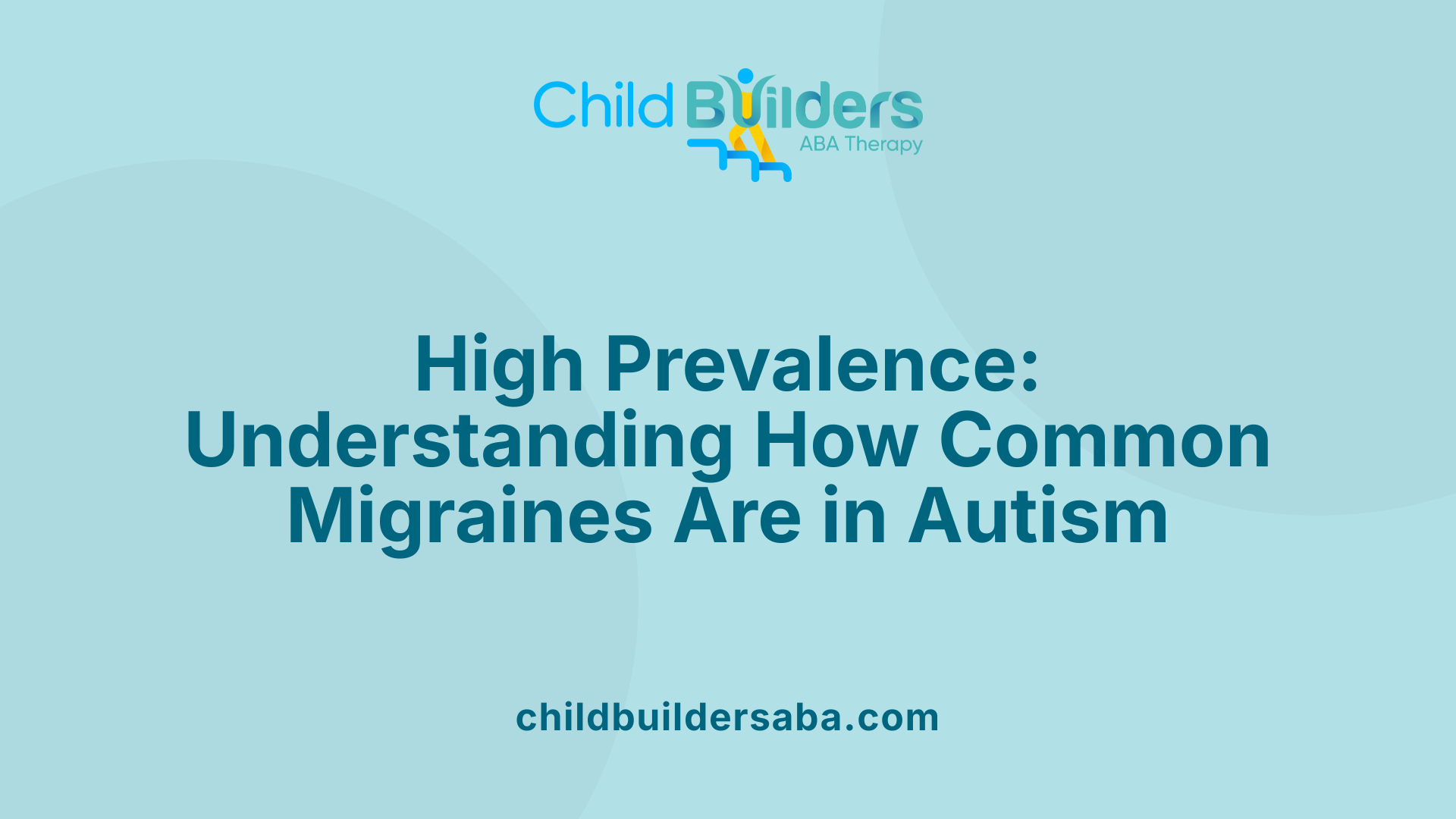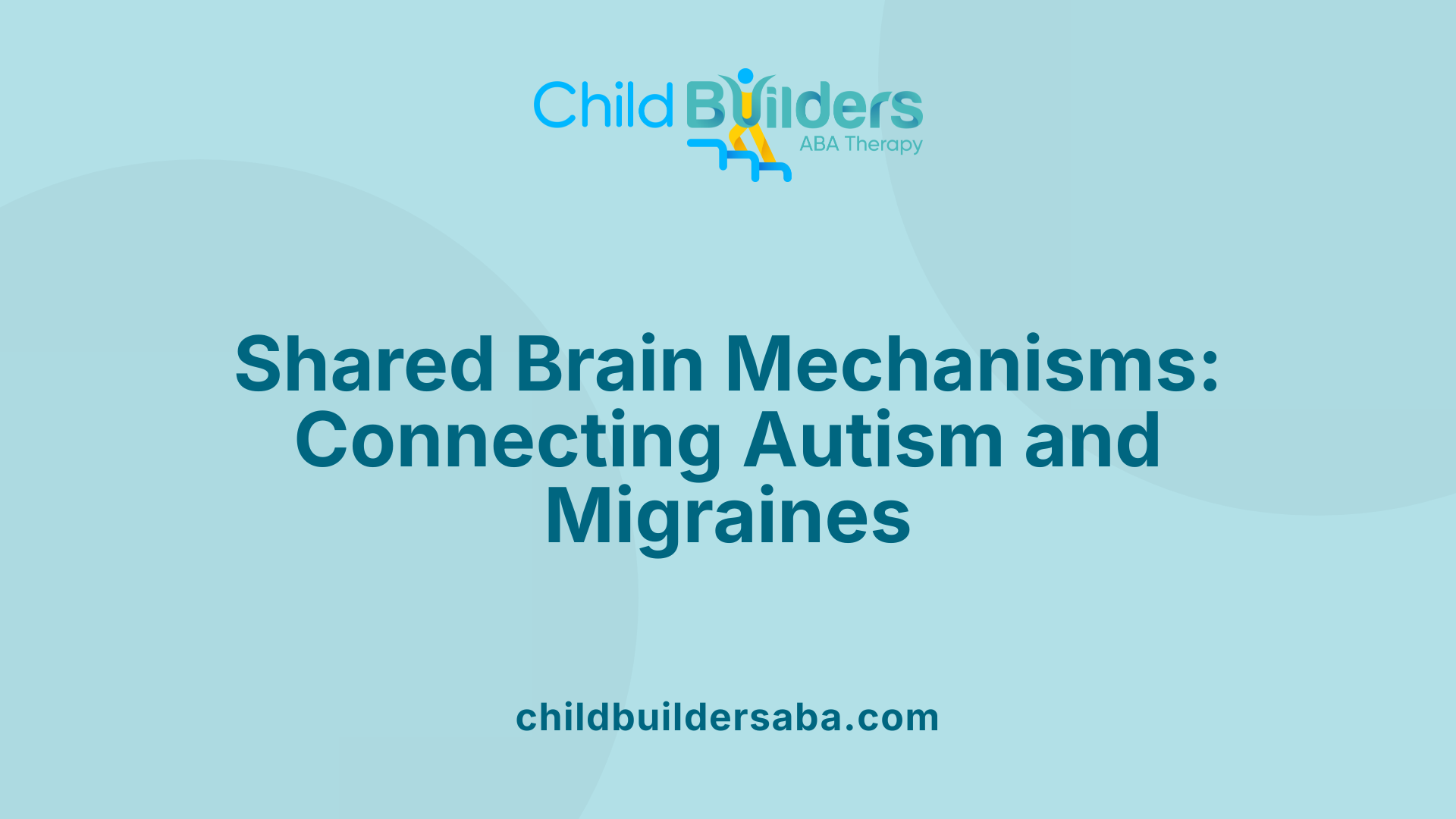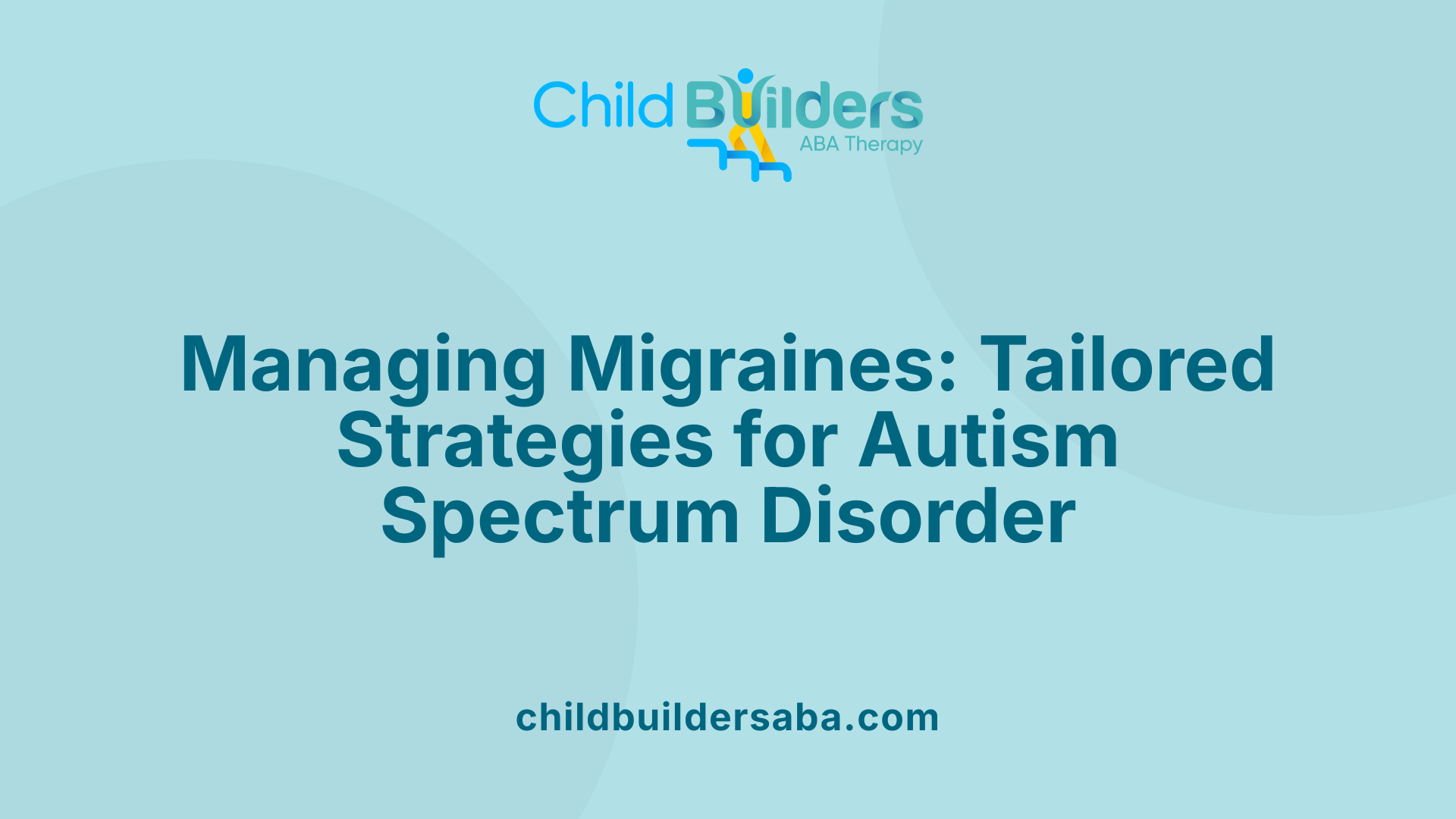Autism and Migraines/Headaches

Understanding the Overlap Between Autism Spectrum Disorder and Migraines
Autism Spectrum Disorder (ASD) is a neurodevelopmental condition characterized by social communication challenges and repetitive behaviors. Emerging research suggests a significant association between ASD and migraines, with implications for diagnosis, management, and understanding shared neurobiological mechanisms. This article explores the prevalence, pathophysiology, assessment, and holistic management approaches, providing comprehensive insights into the complex relationship between autism and headaches.
Prevalence of Migraines in Individuals with Autism

How common are migraines among individuals with autism spectrum disorder?
Research consistently shows that migraines are more prevalent among people with autism spectrum disorder (ASD) than in the general population. Among autistic adults, studies indicate that around 42.7% report having experienced a migraine at some point in their lives. In children with ASD, the prevalence is even higher, with approximately 61% experiencing migraines, including different types such as migraines with and without aura.
This notable increase points to an intriguing link between these two conditions. Both ASD and migraine involve common neurobiological features—such as alterations in serotonin levels, cortical hyperexcitability, and sensory processing differences—that may underpin this association. For instance, neurotransmitter imbalances like hyperserotonemia and abnormalities in serotonin pathways could influence brain development and sensory sensitivities, making individuals with ASD more susceptible to migraines.
Furthermore, genetic studies highlight shared mutations in ion channel genes, such as CACNA1A, SCN1A, and ATP1A2, which are involved in neurodevelopmental disorders including autism and familial hemiplegic migraine. Sensory hyperreactivity, a hallmark of ASD, also correlates strongly with migraine occurrence, especially among those who exhibit heightened sensitivity to light, sound, and touch.
Gender differences are apparent as well. Females with ASD appear particularly vulnerable, possibly due to their higher prevalence of sensory sensitivities and anxiety, which are known triggers for migraine episodes. Overall, the evidence underscores the importance of recognizing migraine as a common comorbidity in the autistic population, emphasizing the need for tailored diagnostic and treatment approaches.
Shared Neurobiological Pathways and Mechanisms

What are the common pathophysiological mechanisms underlying autism and migraines?
Both autism spectrum disorder (ASD) and migraines involve alterations in how the brain processes sensory information, with many shared mechanisms found at the neurobiological level.
One significant factor is sensory processing abnormalities. Individuals with ASD often exhibit sensory hyperreactivity, such as heightened sensitivity to light, sound, and touch. Similarly, migraine sufferers frequently experience photophobia, phonophobia, and more exaggerated responses to sensory stimuli. These shared sensory sensitivities suggest that both conditions involve disruptions in sensory integration and thalamic connectivity, leading to an overwhelmed nervous system.
Neurotransmitter dysregulation, particularly involving serotonin, also plays a role. In autism, hyperserotonemia—an excess of serotonin—is observed in some individuals, affecting brain development and connectivity. Conversely, migraine patients typically exhibit low serotonin levels, which can influence pain pathways and vascular regulation. This dysregulation impacts the brain's normal signaling, potentially contributing to both sensory hypersensitivity and the susceptibility to migraine episodes.
Cortical hyperexcitability and neurovascular changes present another common pathway. Both disorders are characterized by an imbalance between cortical excitation and inhibition, leading to cortical hyperexcitability. This heightened state of neural activity is associated with sensory overload in ASD and the phenomenon of cortical spreading depolarization in migraines, initiating the headache phase. Additionally, neurovascular alterations, including vascular dysregulation and changes in blood flow, further contribute to migraine pathophysiology and may influence cortical functioning in ASD.
Neuroinflammatory processes involving microglia, cytokines, and mast cells are increasingly recognized as central to both conditions. Microglia activation and cytokine release can affect neuronal connectivity and synaptic plasticity. Mast cells, when activated, release neuropeptides and inflammatory mediators that can exacerbate neural excitability and contribute to pain and sensory processing abnormalities. These immune responses suggest that neuroinflammation could be a bridging mechanism, reinforcing the connection between autism and migraine.
Understanding these overlapping mechanisms not only illustrates the complex relationship between ASD and migraines but also points toward potential targets for therapeutic intervention, emphasizing the importance of a holistic approach to treatment.
Genetic and Biological Factors Contributing to the Link
What genetic and biological factors may contribute to the link between autism and migraines?
Several interconnected genetic and biological factors appear to influence the relationship between autism spectrum disorder (ASD) and migraines. Both conditions are associated with abnormalities in neurotransmitter systems, including serotonin and GABA, which regulate neural excitability, sensory processing, and mood.
Mutations in specific ion channel genes such as CACNA1A, SCN1A, and ATP1A2 have been identified in both autism and familial hemiplegic migraine. These genes are involved in channelopathies, which affect the electrical activity of neurons, leading to heightened excitability and synaptic transmission issues.
Neuroinflammation also plays a crucial role. Activation of microglia and imbalances in cytokine levels contribute to overlapping inflammatory pathways, potentially damaging neuronal circuits and exacerbating symptoms common to both disorders.
Brain structure abnormalities, particularly in sensory and thalamic connectivity, have been observed in individuals with ASD and migraine. These changes include altered cortical and thalamic interactions that influence sensory sensitivities like photophobia and phonophobia.
Dysregulation of the brainstem serotonergic system is another shared factor, affecting brain development and the regulation of pain and sensory thresholds.
Research into the genetic overlap indicates that certain gene mutations may predispose individuals to both conditions. For example, mutations affecting ion channels involved in neural signal regulation are common vulnerabilities. Additionally, polygenic risk scores suggest that individuals with higher genetic predisposition for ASD also have an increased likelihood of experiencing migraines.
Understanding these biological and genetic overlaps can improve diagnostic approaches and tailor treatments that target shared pathways, ultimately benefiting many individuals who experience both autism and migraines.
Diagnosis and Clinical Assessment Challenges
How are migraines diagnosed and assessed in autistic individuals?
Diagnosing migraines in individuals with autism spectrum disorder (ASD) presents unique challenges due to communication difficulties and atypical symptom presentation. Clinicians rely heavily on detailed history-taking from caregivers to gather information about the child's pain episodes, behaviors, sleep patterns, and potential triggers. This comprehensive approach helps distinguish migraines from other causes of headache.
Physical examinations are crucial to exclude other medical issues, such as dental problems or neurological abnormalities. When necessary, imaging tests or specialized diagnostics are performed, especially if red flags or neurological concerns are identified.
Because many autistic children experience sensory processing issues and may have difficulty expressing pain verbally, behavioral pain assessment tools become invaluable. Instruments like the revised Face, Legs, Activity, Cry, Consolability scale (r-FLACC) and the Individualized Numeric Rating Scale (INRS) are used to observe and rate pain based on behaviors and reactions.
Autistic individuals may also exhibit behaviors such as self-injury or disruptive actions that can signal underlying pain or discomfort. Recognizing these signals requires a trained, multidisciplinary team familiar with autism-specific presentations.
While there are no definitive blood tests or imaging studies to confirm a migraine diagnosis, combining a thorough medical history, behavioral observations, and careful exclusion of other medical conditions allows clinicians to reliably identify migraines in this group. A multidisciplinary approach ensures a comprehensive assessment tailored to the needs of autistic individuals, improving diagnostic accuracy and guiding appropriate treatment strategies.
Management and Treatment Strategies

What management and treatment strategies are effective for migraines in people with autism?
Treating migraines in individuals on the autism spectrum necessitates a comprehensive, tailored approach that considers the unique sensory sensitivities often present in this population. Recognizing specific triggers such as bright lights, loud noises, or strong smells is vital. Creating routines that help individuals avoid or better tolerate these stimuli can make a significant difference.
Medications are often used to manage acute migraine attacks. Common options include over-the-counter pain relievers like acetaminophen or ibuprofen, and in more severe cases, triptans—medications specifically designed to treat migraines—may be prescribed. It's important that medication use is supervised by healthcare professionals familiar with autism to ensure safety and effectiveness.
Lifestyle modifications also play a key role. Consistent sleep schedules, adequate hydration, stress reduction, and healthy eating habits can reduce the frequency and intensity of migraines. Behavioral interventions, such as cognitive-behavioral therapy (CBT), can teach coping strategies for managing pain and stress.
Creating sensory-friendly environments is another crucial element. This may involve adjusting lighting, reducing noise levels, and providing sensory breaks during stressful or overload situations. Such modifications can help minimize sensory overload that often triggers migraines.
Collaboration among healthcare providers—including neurologists, psychologists, occupational therapists, and primary care physicians—is essential to develop an individualized treatment plan. This multidisciplinary approach ensures that both migraine symptoms and the broader sensory and behavioral needs are addressed, promoting overall well-being.
By integrating these strategies—medication, behavioral techniques, environmental adjustments, and professional support—patients with autism can achieve better management of migraines, improving their daily functioning and quality of life.
Research Evidence Supporting the Autism-Migraine Connection

Are there any research findings on the correlation between autism and migraines or headaches?
Research indicates a strong link between autism spectrum disorder (ASD) and higher rates of migraines. Studies from 2014 and 2019 highlight this association, showing that a significant portion of individuals with ASD experience migraines. For example, a 2014 study involving 18 autistic children found that 61% suffered from migraine headaches. Similarly, a 2019 study involving 105 autistic adults reported that 42.7% experienced migraines during their lifetime, compared to only 20.5% in non-autistic controls.
These findings suggest that migraines are notably more common in those with ASD. Beyond prevalence, research reveals shared neurophysiological features, like sensory hyper-responsiveness, altered thalamic connectivity, and irregular serotonergic activity. Autistic individuals often show heightened sensitivity to sensory stimuli, which is also a characteristic migraine trigger.
Furthermore, both conditions share risk factors such as increased anxiety and sleep disturbances. Genetic studies add another layer, highlighting mutations in ion channel genes like CACNA1A, SCN1A, and ATP1A2 that are implicated in both ASD and familial hemiplegic migraine.
Overall, the body of evidence underscores a significant association between autism and migraines, rooted in overlapping neural mechanisms and shared risk factors. Despite these advances, researchers emphasize the need for further studies to fully understand the intricate biological links and to improve diagnosis and management strategies for individuals affected by both conditions.
Holistic and Supportive Care Approaches

What holistic and supportive approaches can assist in managing migraines and related conditions in autism?
Managing migraines in individuals with autism benefits from a comprehensive approach that incorporates various holistic and supportive techniques. These methods aim to reduce the frequency and severity of migraines while also improving overall well-being.
Mindfulness and relaxation techniques are especially helpful. Practices such as meditation, deep breathing exercises, and progressive muscle relaxation can decrease stress levels, which are common triggers for migraines. Biofeedback therapy is another effective tool that trains individuals to control physiological functions like muscle tension and blood flow.
Creating sensory-friendly environments plays a critical role. Reducing overwhelming stimuli—such as bright lights, loud noises, and strong smells—can lessen sensory overload, a known factor in both autism and migraine episodes. Using tools like noise-canceling headphones, dim lighting, and calming sensory objects can help.
Dietary modifications also contribute significantly. Avoiding foods that are known to trigger migraines—like processed foods, artificial sweeteners, and caffeine—can help manage attacks. Supplementation with minerals such as magnesium and vitamins like riboflavin (vitamin B2) has shown promise in reducing migraine frequency.
In addition to these strategies, maintaining good sleep hygiene, staying well-hydrated, and employing stress management techniques are essential components of supportive care. Regular physical activity, such as yoga or gentle stretching, can also promote relaxation and improve mood.
Healthcare providers and caregivers should work collaboratively to craft personalized routines that incorporate these approaches safely. Consulting with medical professionals ensures that holistic therapies complement existing treatments and are appropriate for each individual's unique needs.
Implications for Healthcare and Future Research
Healthcare professionals, researchers, and caregivers should recognize that both autism spectrum disorder (ASD) and migraine are complex conditions with overlapping features. These include sensory processing sensitivities, sleep issues, anxiety, and shared genetic factors, such as mutations affecting ion channels. In children with ASD, the prevalence of migraine is notably higher, with studies indicating around 61% of autism children experience migraines, often with varied types like with or without aura.
Diagnosing migraines in autistic individuals can be challenging, especially in non-verbal or minimally verbal children. Communication barriers and atypical symptom presentation make it necessary to develop specialized assessment tools. Multidisciplinary approaches combining behavioral assessments and thorough medical evaluations are essential.
Research highlights neurobiological overlaps, notably serotonergic dysregulation, cortical hyperexcitability, and altered thalamic connectivity. These shared features suggest common pathways that may be targeted in future intervention strategies. Genetic studies pointing to mutations in genes such as CACNA1A, SCN1A, and ATP1A2 underline a genetic overlap involving channelopathies.
In adults, increasing awareness about the propensity for migraines among autistic individuals is crucial. Understanding and addressing increased sensory sensitivities and pain thresholds can help tailor strategies for managing migraines more effectively.
Encouraging interdisciplinary research is vital to further explore the genetic, neurobiological, and immune components linking ASD and migraines. Such efforts could lead to personalized treatments and preventive measures.
| Aspect | Details | Additional Notes |
|---|---|---|
| Population | Higher prevalence in children (~61%) and adults (~42.7%) with ASD | Based on various studies including 2014 and 2019 data |
| Shared Features | Sensory hyperreactivity, serotonin abnormalities, cortical hyperexcitability | Explains common clinical presentations |
| Genetic Factors | Mutations in ion channel genes (CACNA1A, SCN1A, ATP1A2) | Link to channelopathies |
| Challenges | Diagnostic difficulties, communication barriers | Need for tailored evaluation tools |
| Future Directions | Focus on personalized intervention, immune pathways | Promote early detection and support |
Autistic Burnout and Its Role in Migraine Development
What is autistic burnout and how does it relate to migraines?
Autistic burnout is a state of deep mental, emotional, and physical exhaustion that occurs when individuals on the autism spectrum face overwhelming demands or persistent stressors. It often manifests through symptoms such as heightened anxiety, increased sensory sensitivities, difficulties with social communication, and a loss of interest in previously enjoyed activities.
This intense state of fatigue and sensory overload not only affects mental health but also has physical repercussions. Common physical symptoms include muscle tension, sleep disruptions, and general fatigue. These physiological and psychological stressors can trigger migraines, especially in individuals already prone to sensory sensitivities.
How do autistic burnout and stress relate to migraines in autistic individuals?
Research indicates a strong link between the stress experienced during autistic burnout and the onset of migraines. The overload of sensory stimuli and emotional exhaustion can act as direct triggers, leading to episodes of severe headache. Particularly for autistic individuals with heightened sensory sensitivities, even benign stimuli like bright lights or loud sounds can provoke migraines.
Stress management plays a crucial role in mitigating these episodes. By reducing stress and sensory overload, individuals can lower their risk of experiencing migraines.
Impact on mental and physical health
Autistic burnout compounds the challenges faced by autistic individuals. The persistent exhaustion and stress not only increase migraine frequency but can also contribute to broader health issues, including anxiety, depression, and social withdrawal. The cyclical nature of burnout and migraines can create a vicious cycle, where each condition worsens the other.
Strategies for management and reducing burnout
Effective management involves a holistic approach. Establishing predictable routines can provide stability and reduce anxiety. Sensory breaks—especially in calming environments—help prevent overload.
Mindfulness practices, such as deep breathing or meditation, can diminish stress levels. Ensuring adequate hydration, maintaining regular sleep patterns, and creating sensory-friendly spaces are also vital. When migraines occur, seeking medical advice for appropriate treatment can alleviate discomfort and prevent further episodes.
Proactively addressing burnout and managing sensory sensitivities not only improves overall well-being but also reduces the frequency and severity of migraines, fostering a better quality of life for autistic individuals.
Moving Towards Better Understanding and Support
Recognizing the intricate relationship between autism and migraines is vital for improving diagnosis, management, and quality of life for affected individuals. As research advances, a neurobiological understanding emphasizing shared pathways, genetic factors, and sensory processing differences can inform targeted interventions. Multidisciplinary approaches, inclusive of behavioral, medical, and holistic strategies, are essential. Raising awareness among healthcare providers, caregivers, and researchers will foster early detection, personalized care, and better support systems, ultimately reducing the burden of headaches in the autism community.
References
- Autism and Migraine: An Unexplored Association? - PMC
- Autism and migraine: Link and possible causes - Medical News Today
- Autism and Migraine: A Narrative Review - PMC - PubMed Central
- Autism and Migraines: Is There a Connection? - APM
- [PDF] Autism and Migraine: A Narrative Review | Cureus
- Autism Spectrum Disorder and Migraines
- What You Should Know about Autistic Burnout and Migraines
- with and without aura are associated with polygenic scores for autism
- Coping with Autism and Migraines/Headaches - ABA Therapist Jobs
- Migraine Headaches - Adult Autism Health Resources





































































































